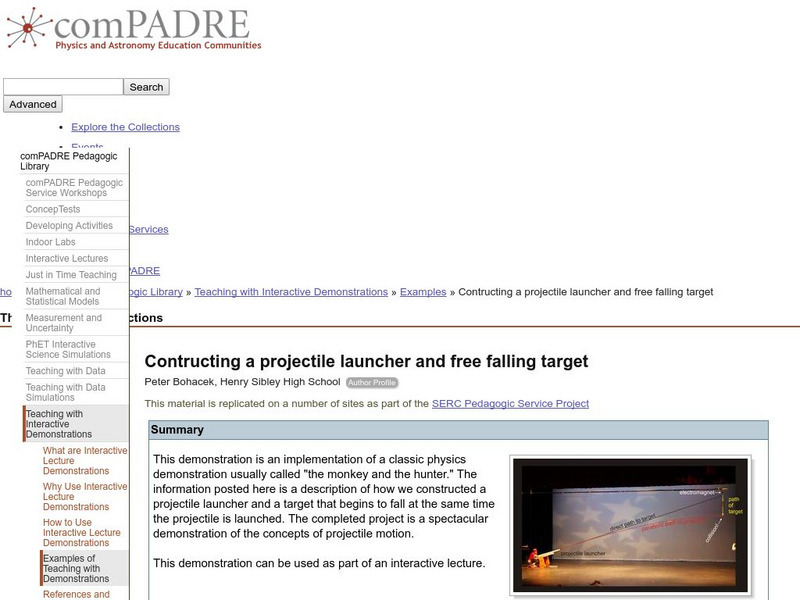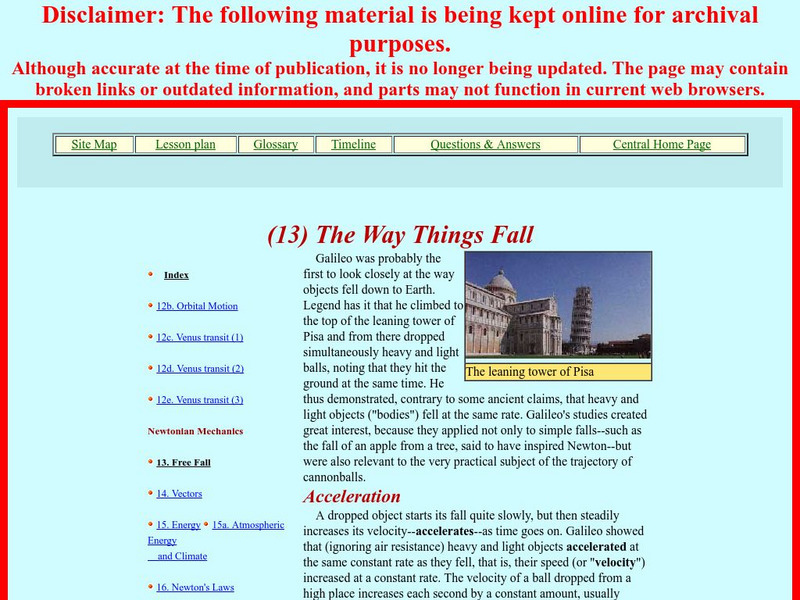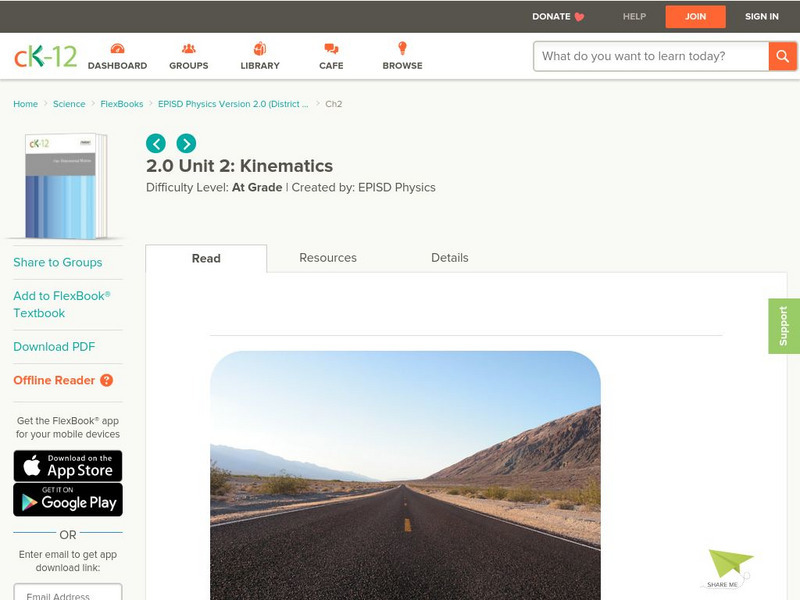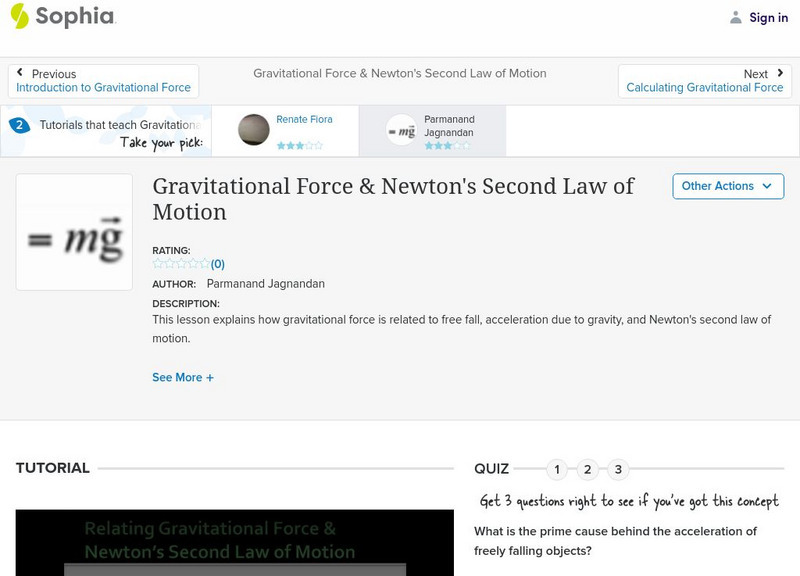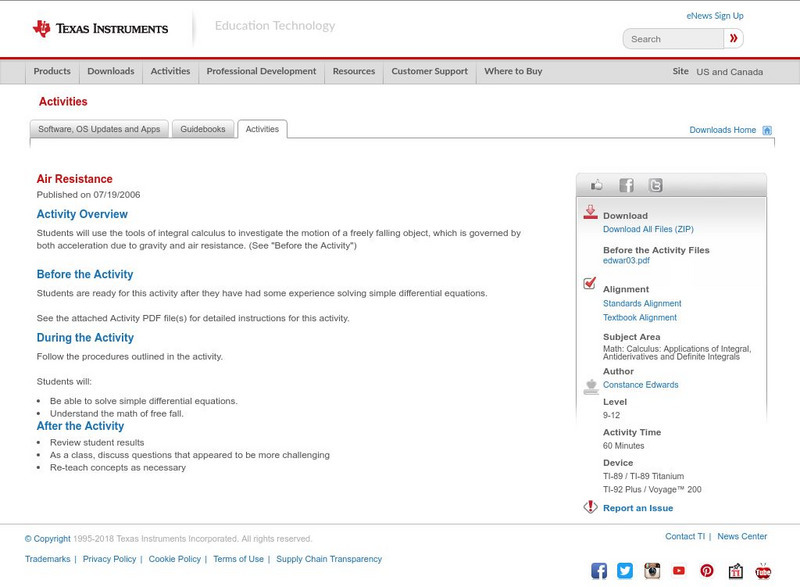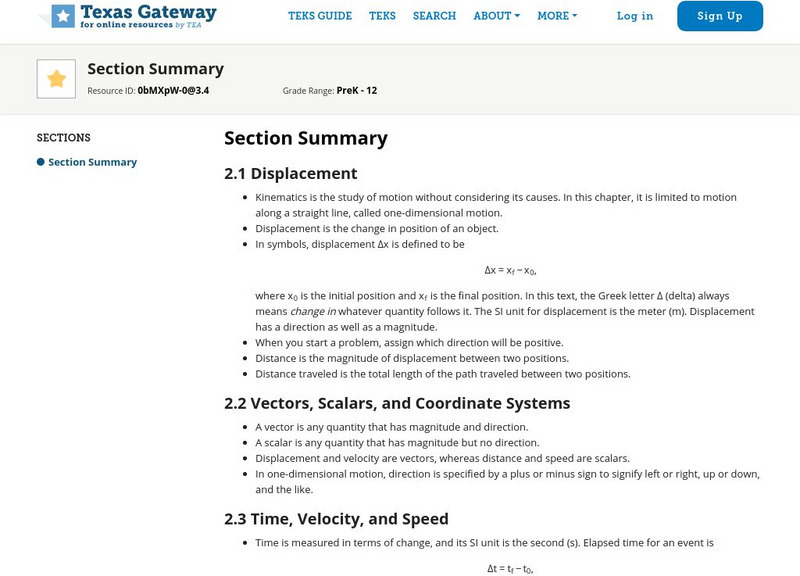Texas Education Agency
Texas Gateway: Kinematics: Falling Objects
By the end of this section, you will be able to describe the effects of gravity on objects in motion, describe the motion of objects that are in free fall, and calculate the position and velocity of objects in free fall.
Science Education Resource Center at Carleton College
Serc: Constructing a Projectile Launcher and Free Falling Target
Implement the classic physics demonstration "the monkey and the hunter" using this description of a projectile launcher and a target that begins to fall at the same time the projectile is launched. The completed project is a spectacular...
Sophia Learning
Sophia: Newton's Second Law of Motion & Free Fall: Lesson 1
This lesson explains how Newton's second law of motion can be used to understand free fall. It is 1 of 2 in the series titled "Newton's Second Law of Motion & Free Fall."
Exploratorium
Exploratorium: Science Snacks: Physics/mechanics (Force and Motion)
A collection of mechanics activities. Many pertain to Newton's laws of motion. Step-by-step directions provided with illustrations. Great for teacher demos or student projects.
Annenberg Foundation
Annenberg Learner: Amusement Park Physics: The Principles of Free Fall
An article describing free fall principles in roller coaster rides. In addition to the explanation of free fall, an experiment is described that allows you to test free fall with a cup of water. Part of a larger presentation on roller...
NASA
Nasa: The Way Things Fall
This site from NASA compares free falling motion to falling with air resistance. Discusses Galileo's experiment. Explains why we believe all objects free fall with the same acceleration.
CK-12 Foundation
Ck 12 Exploration Series: Simulations: Physics: Model Rocket
[Free Registration/Login Required] Learn about the relationship between position and velocity for a model rocket during launch and in free-fall. Experiment with rocket mass, rocket thrust, and rocket burn time to understand the...
CK-12 Foundation
Ck 12: Episd: Physics: Kinematics
[Free Registration/Login may be required to access all resource tools.] An online chapter focused on motion and the shapes it takes. Topics range from speed and velocity to acceleration and free fall. Find detailed visuals, learning...
OpenStax
Open Stax: Falling Objects
In the following interactive module, students will describe the effects of gravity on objects in motion. They will also describe the motion of objects that are in freefall and calculate the position and velocity of objects in freefall.
Texas Instruments
Texas Instruments: Falling Objects
In this activity, Students can use a Motion Detector to measure distance and velocity.
Sophia Learning
Sophia: Gravitational Force & Newton's Second Law of Motion
This lesson explains how gravitational force is related to free fall, acceleration due to gravity, and Newton's second law of motion.
Physics Classroom
The Physics Classroom: Newton's Laws of Motion
Use this outline to find out about Newton's Laws of Motion. Use the different lesson plans covering the laws of motion to learn more.
Physics Classroom
The Physics Classroom: 1 D Kinematics: Table of Contents
Learners examine motion with words, equations, diagrams, and graphs. Some topics investigated are position, velocity, acceleration, and free fall. The tutorial consists of lessons and problems to check for understanding.
Texas Instruments
Texas Instruments: Motion in One Dimension & Freefall Motion
This activity is designed to assess the comprehension of concepts related to motion in one dimension and freefall motion.
Concord Consortium
Concord Consortium: Stem Resources: Was Galileo Right?
Do heavier and lighter objects fall at the same rate? Galileo hypothesized that objects fall at the same rate regardless of their mass. Complete this module to find out if Galileo was right by comparing position-time and velocity-time...
Khan Academy
Khan Academy: Freefall Review
Review the key concepts and skills for acceleration due to gravity, including analyzing motion of objects in freefall.
University of New South Wales (Australia)
University of New South Wales: School of Physics: Physclips: Projectiles
Physiclips introduces the concept of projectiles with animations and film clips.
Texas Instruments
Texas Instruments: Air Resistance
Use the TI-89 to investigate the effect of air resistance on a free-falling object. Examples in the activity use calculator screenprints and keystroke instructions to demonstrate the use of the calculator to solve these problems....
Physics World
Physics World: Contextual Physics in Ocean Park
After downloading the "Motion Video Analysis" software, users can collect data about moving object's position from digital movie clips. This collection of data will allow them to plot motion graphs and draw conclusions about physics in...
Texas Education Agency
Texas Gateway: Kinematics Section Summary
This is a summary of the main topics for AP Physics Chapter 2 Kinematics. These include Displacement; Vectors, Scalars, and Coordinate Systems; Time, Velocity, and Speed; Acceleration; Motion Equations for Constant Acceleration in One...
Physics Classroom
The Physics Classroom: 1 D Kinematics: Acceleration of Gravity
The practice problems and illustrated examples in this tutorial help students understand the acceleration of gravity. The 'Value of g' widget the tutorial refers to can be found in the Interactives section (link is in side-bar) under...
NASA
Nasa: Beginner's Guide to Aerodynamics
Includes exhaustive information and a wealth of activities pertaining to aerodynamics and the physics of flight.
Physics Aviary
Physics Aviary: Drone Delivery Lab
This lab is designed to have students find the relationships that govern the behavior of a package that has been released by a drone that is flying horizontally. Students will have control over the drone's height and horizontal speed....
Physics Aviary
Physics Aviary: Pvc Freefall
This lab was designed to give students practice collecting and analyzing data for the PVC Freefall Lab. Masses are dropped from different heights and the speed of the object as it passes through a photogate is calculated. The...



